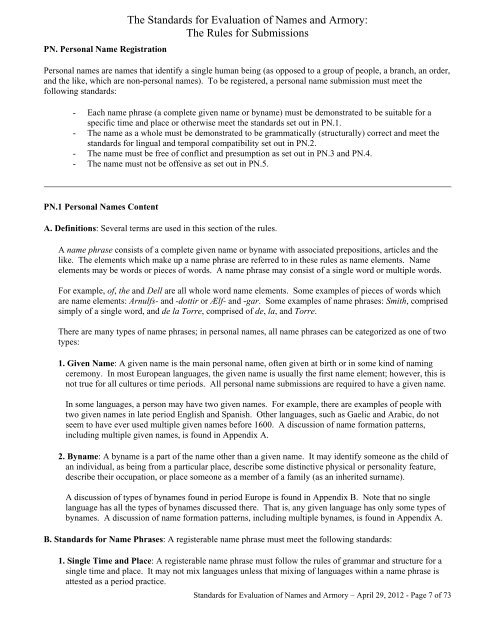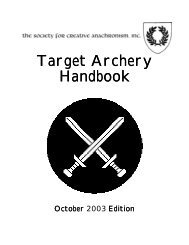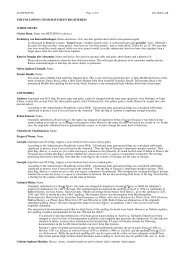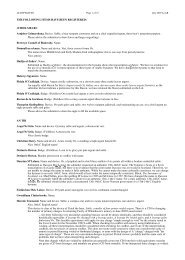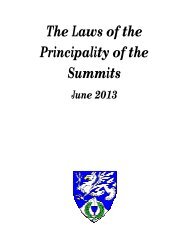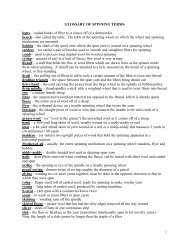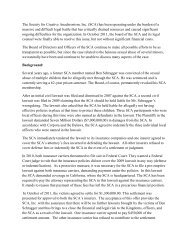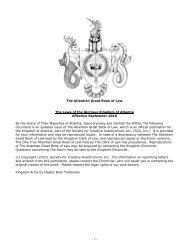The Standards for Evaluation of Names and Armory - SCA Heraldry
The Standards for Evaluation of Names and Armory - SCA Heraldry
The Standards for Evaluation of Names and Armory - SCA Heraldry
Create successful ePaper yourself
Turn your PDF publications into a flip-book with our unique Google optimized e-Paper software.
PN. Personal Name Registration<strong>The</strong> <strong>St<strong>and</strong>ards</strong> <strong>for</strong> <strong>Evaluation</strong> <strong>of</strong> <strong>Names</strong> <strong>and</strong> <strong>Armory</strong>:<strong>The</strong> Rules <strong>for</strong> SubmissionsPersonal names are names that identify a single human being (as opposed to a group <strong>of</strong> people, a branch, an order,<strong>and</strong> the like, which are non-personal names). To be registered, a personal name submission must meet thefollowing st<strong>and</strong>ards:- Each name phrase (a complete given name or byname) must be demonstrated to be suitable <strong>for</strong> aspecific time <strong>and</strong> place or otherwise meet the st<strong>and</strong>ards set out in PN.1.- <strong>The</strong> name as a whole must be demonstrated to be grammatically (structurally) correct <strong>and</strong> meet thest<strong>and</strong>ards <strong>for</strong> lingual <strong>and</strong> temporal compatibility set out in PN.2.- <strong>The</strong> name must be free <strong>of</strong> conflict <strong>and</strong> presumption as set out in PN.3 <strong>and</strong> PN.4.- <strong>The</strong> name must not be <strong>of</strong>fensive as set out in PN.5.PN.1 Personal <strong>Names</strong> ContentA. Definitions: Several terms are used in this section <strong>of</strong> the rules.A name phrase consists <strong>of</strong> a complete given name or byname with associated prepositions, articles <strong>and</strong> thelike. <strong>The</strong> elements which make up a name phrase are referred to in these rules as name elements. Nameelements may be words or pieces <strong>of</strong> words. A name phrase may consist <strong>of</strong> a single word or multiple words.For example, <strong>of</strong>, the <strong>and</strong> Dell are all whole word name elements. Some examples <strong>of</strong> pieces <strong>of</strong> words whichare name elements: Arnulfs- <strong>and</strong> -dottir or Ælf- <strong>and</strong> -gar. Some examples <strong>of</strong> name phrases: Smith, comprisedsimply <strong>of</strong> a single word, <strong>and</strong> de la Torre, comprised <strong>of</strong> de, la, <strong>and</strong> Torre.<strong>The</strong>re are many types <strong>of</strong> name phrases; in personal names, all name phrases can be categorized as one <strong>of</strong> twotypes:1. Given Name: A given name is the main personal name, <strong>of</strong>ten given at birth or in some kind <strong>of</strong> namingceremony. In most European languages, the given name is usually the first name element; however, this isnot true <strong>for</strong> all cultures or time periods. All personal name submissions are required to have a given name.In some languages, a person may have two given names. For example, there are examples <strong>of</strong> people withtwo given names in late period English <strong>and</strong> Spanish. Other languages, such as Gaelic <strong>and</strong> Arabic, do notseem to have ever used multiple given names be<strong>for</strong>e 1600. A discussion <strong>of</strong> name <strong>for</strong>mation patterns,including multiple given names, is found in Appendix A.2. Byname: A byname is a part <strong>of</strong> the name other than a given name. It may identify someone as the child <strong>of</strong>an individual, as being from a particular place, describe some distinctive physical or personality feature,describe their occupation, or place someone as a member <strong>of</strong> a family (as an inherited surname).A discussion <strong>of</strong> types <strong>of</strong> bynames found in period Europe is found in Appendix B. Note that no singlelanguage has all the types <strong>of</strong> bynames discussed there. That is, any given language has only some types <strong>of</strong>bynames. A discussion <strong>of</strong> name <strong>for</strong>mation patterns, including multiple bynames, is found in Appendix A.B. <strong>St<strong>and</strong>ards</strong> <strong>for</strong> Name Phrases: A registerable name phrase must meet the following st<strong>and</strong>ards:1. Single Time <strong>and</strong> Place: A registerable name phrase must follow the rules <strong>of</strong> grammar <strong>and</strong> structure <strong>for</strong> asingle time <strong>and</strong> place. It may not mix languages unless that mixing <strong>of</strong> languages within a name phrase isattested as a period practice.<strong>St<strong>and</strong>ards</strong> <strong>for</strong> <strong>Evaluation</strong> <strong>of</strong> <strong>Names</strong> <strong>and</strong> <strong>Armory</strong> – April 29, 2012 - Page 7 <strong>of</strong> 73


